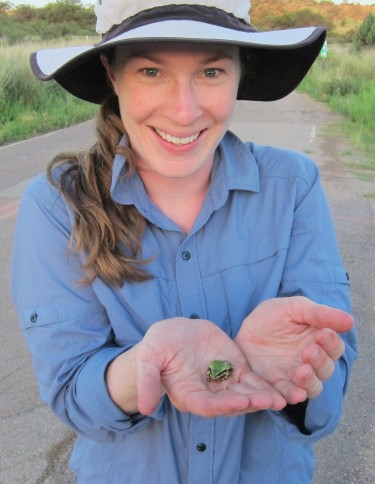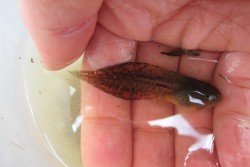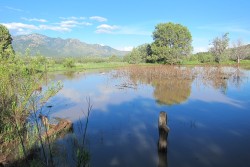
With two degrees under her belt and dissertation research to complete, Meryl Mims found herself in southeastern Arizona’s Sky Islands in the summer of 2013. In a landscape known for the juxtaposition of its sprawling features—where towering, forested mountains seep upward through the desert’s dry, cracked surface—a two-inch long frog captured Mims’ attention.
“We were already out there and we were hearing the Arizona treefrogs. It’s like they were calling us in,” Mims said.
Arizona treefrogs, a species of conservation concern, are brilliantly green with dark markings that run like mascara across their eyelids and down their bodies. The treefrogs live in three distinct ranges—most live in two mountainous regions in central Arizona and Mexico, and another smaller, isolated group lives along the U.S./Mexico border in the Huachuca Mountains. Even though the smaller range consists of true Arizona treefrogs, they are biologically and genetically different from those in the larger ranges. Surveys of the treefrogs in the Huachuca Mountains over the last two decades suggest that the populations are small and possibly in decline, and local extinction of this group would represent a loss of diversity within the species and create a significant geographic gap between the two larger ranges.
A spinoff from her dissertation research, Mims wanted to dig deeper into that question—are populations in this group indeed small? Are they threatened? Is this segment of treefrogs actually declining or are the individuals just difficult to locate? If you do find them, how do you measure the population size and the degree to which the populations interconnected? Mims hoped that by answering some of these questions, she could aid in the development of an effective plan for the conservation and management of the species.
Mims and Trevor Eakes, an undergraduate volunteer from School of Aquatic and Fishery Sciences, hit the ground running after Mims was chosen as a recipient of the College of the Environment’s first-ever Hall Conservation Genetics Research Award in early-2014. They arrived in the Huachucas just as summer monsoon season was setting in—breeding season for the Arizona treefrog. These nocturnal amphibians breed once a year in the temporary ponds created by summertime deluges. Gulping energy drinks to stay awake through the night, Mims and Eakes would spring into action when they came across a breeding pond, trying to collect and record their data before the next line of storms passed through.
During this time, Mims and Eakes discovered two additional breeding sites within the range that hadn’t been catalogued before and even determined that one known breeding site extends about four miles south of what had been previously recorded. Where they had expected to see 30 or fewer Arizona treefrogs at ponds, they found hundreds—substantially larger than what they had expected to see. While there are lingering concerns about predation by nonnative bullfrogs, drier conditions due to climate change, and the increased intensity and frequency of wildfires, the populations of Arizona treefrogs in the Huachuca range appear to be more robust than previously thought. Through this work, Mims found that management of breeding habitats, control of nonnative predators, and maintaining connectivity between populations will be important for this small range and for the species as a whole moving forward.
When she talks about her research, Mims’ words brim with excitement. She’s articulate about her passion for science that can be applied through policy decisions and species management, and clings to freshwater ecology like she’s lucky to have stumbled into the field.
Studying for her Ph.D. in Aquatic and Fishery Sciences, Mims traces her passion for the environment to her formative years on lakes and rivers in Florida’s panhandle region.
“We spent hours face down in the water, snorkeling and grabbing scallops from the grassy bottom of St. Joseph Bay,” Mims said. “Scallops were always the objective, but there were so many other animals to see—stingrays, flounder, redfish, sea stars, conches, and urchins. Getting kids outside is so important. You may not realize it then, but you’ll draw inspiration from those moments throughout your life.”

In order to study the population genetics of the Arizona treefrog, an extension of her dissertation research, Mims needed to find support. It led her to submit an application to the College of the Environment’s new Hall Conservation Genetics Scholars Award.
Ben Hall, co-founder of the award along with his wife Margaret and University of Washington alum said, “The Hall Conservation Genetics Scholars Award arose from my family’s multi-generational interest in conservation education. It was established to support scholars early in their careers when research funding is often scarce. Meryl’s doctoral research on the Arizona treefrog exemplifies the kind of conservation genetic research the program was designed to support.”

On the heels of last summer’s work, Mims and scientists from the University of Idaho and Washington State University are teaming up to take her findings a step further. By combining Mims’ research and their environmental DNA samples, they hope to add another layer to our understanding of the species, their current status and overall health, and help create a more robust body of work for the United States Forest Service and other stakeholders to pull from when assessing how to manage the Arizona treefrog moving forward.
“Support from the Halls gave me the freedom to explore something I’m passionate about; something that’s important to the future of this species,” Mims said.
An early-formed fascination with underwater goings-on blossomed into a career focused on addressing freshwater conservation challenges. While that early interaction with wild places and a team of supporters at the University of Washington (including her faculty advisor Julian Olden, her interdisciplinary Ph.D. committee, and funders like the Halls) have been critical, Mims’ innate passion and forward momentum landed her where she is today. She may consider herself lucky to have stumbled into ecology, but the field, its scientists, and the species they’re working to understand are just as lucky to have her as a champion.

